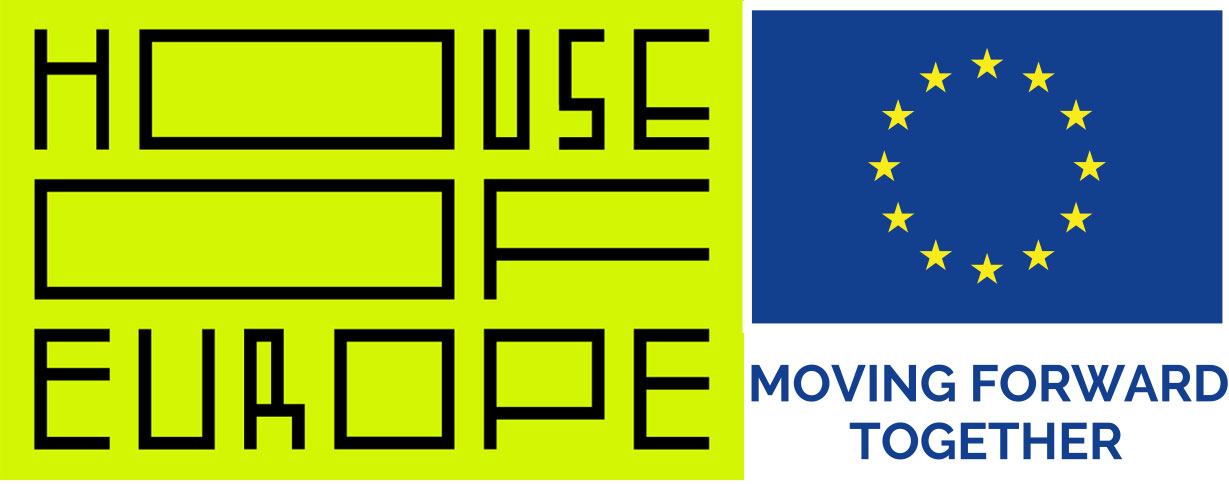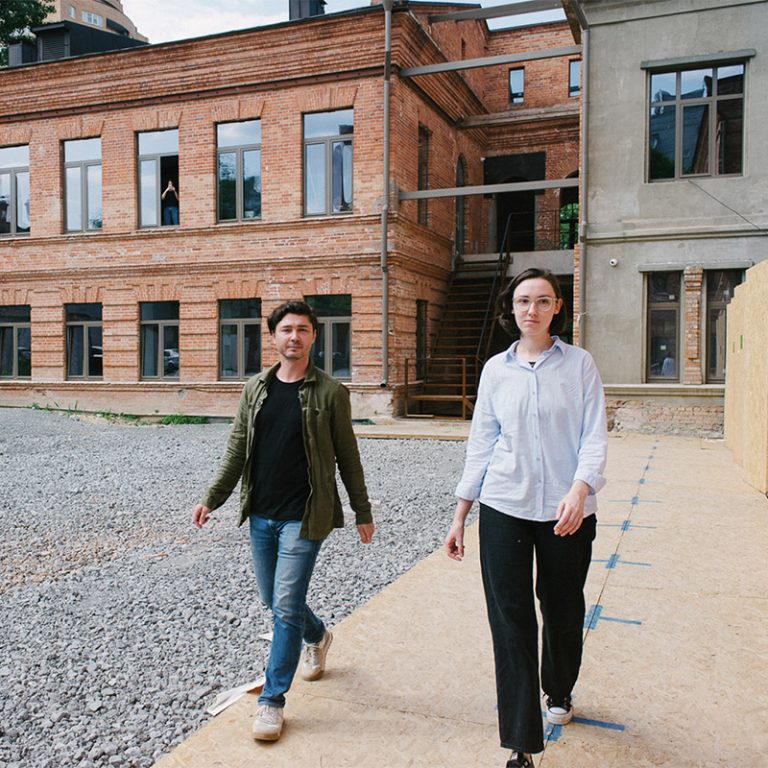The Center for Contemporary Culture in Dnipro is a new center of the city’s artistic life, where festivals, exhibitions, and concerts are held. Having trudged a difficult path in search of a permanent location, the center operates in the place of the former territorial council. Andrii Palash, the co-founder and head of the Kultura Medialna center and public organisation, together with his friends, has been connecting the city’s cultural community since 2018. They attach new importance to abandoned buildings, establish international relations, and help young artists to start their creative careers.
Due to the rocket industry, which was the main industry of Dnipro city, it had a conditionally closed status until the end of the Soviet era. The Center for Culture is a kind of personification of Dnipro: just like the city, the building of the Center was closed for a long time. Actually, it did not lose its historical value and now needs to be rethought. The organisers put new, modern meanings into it while opening the Center for Cultural and Dnipro to the world.
Today, the Dnipro Center for Contemporary Culture (abbreviated as DCCC) has several residents: the Kultura Medialna public organisation, the Artsvit gallery, the Ksi Prostir art workshop, the Department of the French public organisation called Alliance Française, and the Czech Center. The founders are constantly looking for like-minded people with similar values to work together to develop the city’s cultural life.

Discover Dnipro city again
In the second half of the 20th century, Dnipro city was separated from the outside world. This was a city with priority for the rocket industry and faith in the space future which did not accept foreign tourists. In the 1950s, heavy industry enterprises began to appear: the flagship of the rocket industry called the Southern Machine-Building Plant (Pivdenmash), the Design Bureau called Pivdenne, the Prydniprovsk Thermal Power Station, and later a Plant for Heavy Hydraulic Presses and a Tire Plant. The city was developing in an industrial direction, says Kateryna Rusetska, the co-founder of DCCC and Kultura Medialna.
“The mindset of a closed city can still be felt today. Such a mental dome has been preserved over the city, and all cultural organisations and public figures are trying to work both with this legend and with this property in general, which still remains since the Soviet Union.”
Streets and entire neighborhoods were built around factories and plants. Now some of these factories are closed, and some buildings are empty. According to the organisers of the Center for Contemporary Culture, this is the main potential of the city for developing by creative industries that could transform these spaces into galleries, exhibition halls, or hubs.
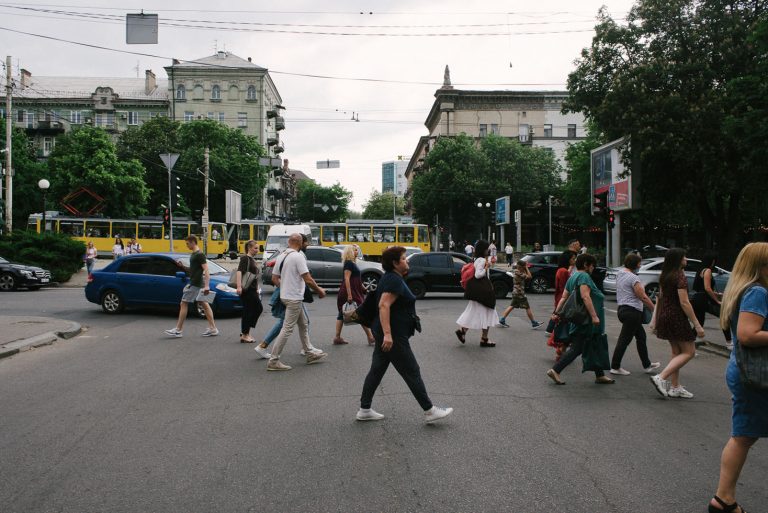
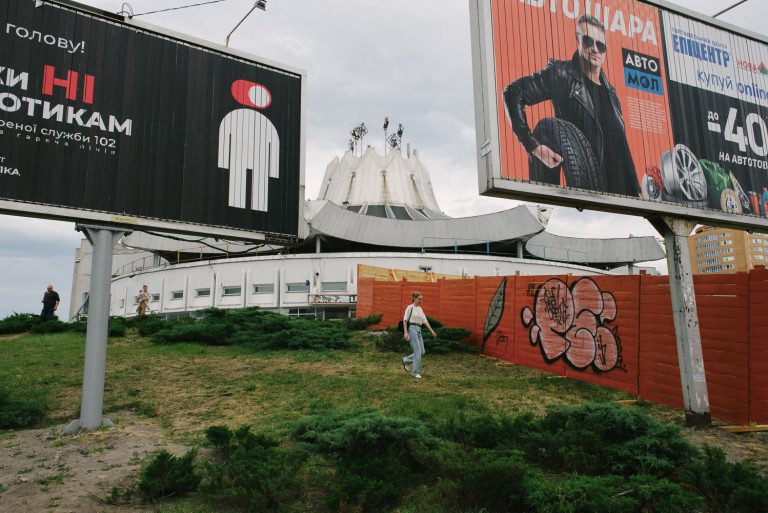
slideshow
The Center’s team says that there is a certain phenomenon in the cultural life of Dnipro: the city of a million people has quite a few initiatives that have experience in holding cultural or artistic events. Andrii Palash says that the Center’s team does not treat this as a problem though. On the contrary, such conditions contribute to the unification of the creative community.
In Ukraine, there are already a number of examples of modern cultural institutions that are based in old or abandoned buildings. So, in Kherson, Urban CAD, a center for creative industries, was opened on the territory of a machine-building plant. In 2020, in a Lviv architectural monument building, which also remained ignored for a long time, a Municipal Art Centerwas opened. Bright revitalisation projects also include Promprylad.Renovation in Ivano-Frankivsk — an innovative space based in an old factory.

DCCC. How it all started
In 2015, Andrii Palash, together with like-minded people, decided that the city needed a new space to realise the cultural potential of Dnipro city. At that time, Kultura Medialna had already organised The Construction festival two years in a row. This is an international festival of audiovisual art and new media in the urban space, which has been held since 2014. The theme of performances and pop-up events revolved around post-industrialism and post-Soviet realities.
“With modern formats, we are trying to rethink the concepts of these old buildings or draw attention to them so that a new life begins there.”
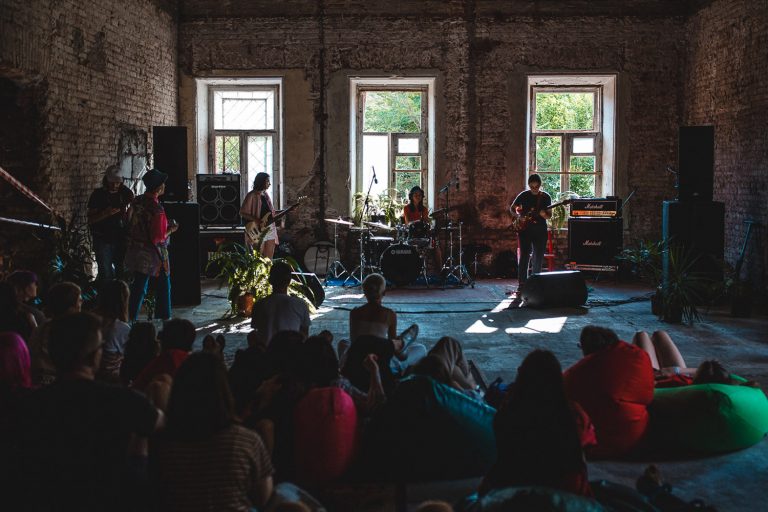
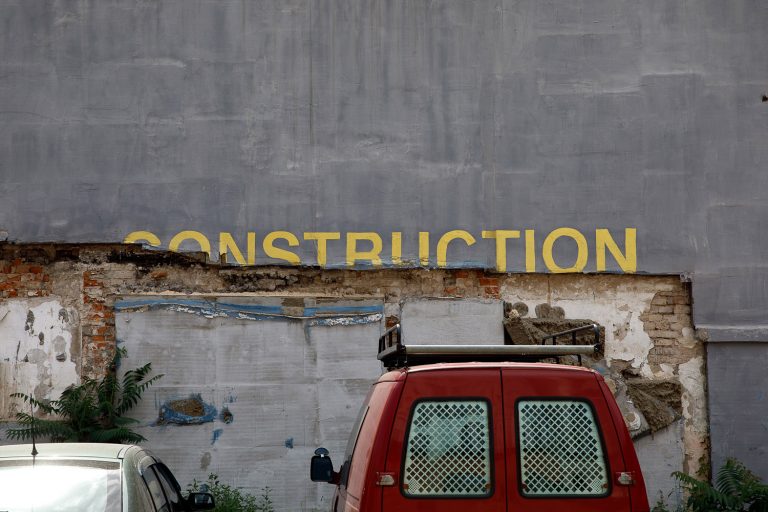
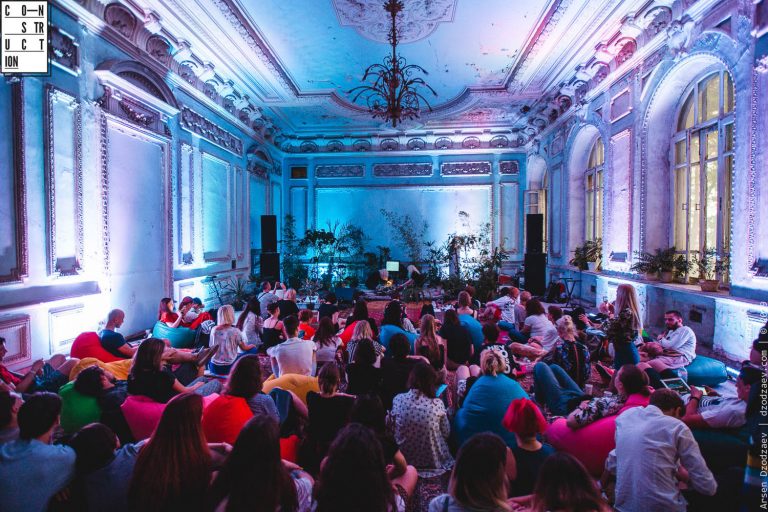
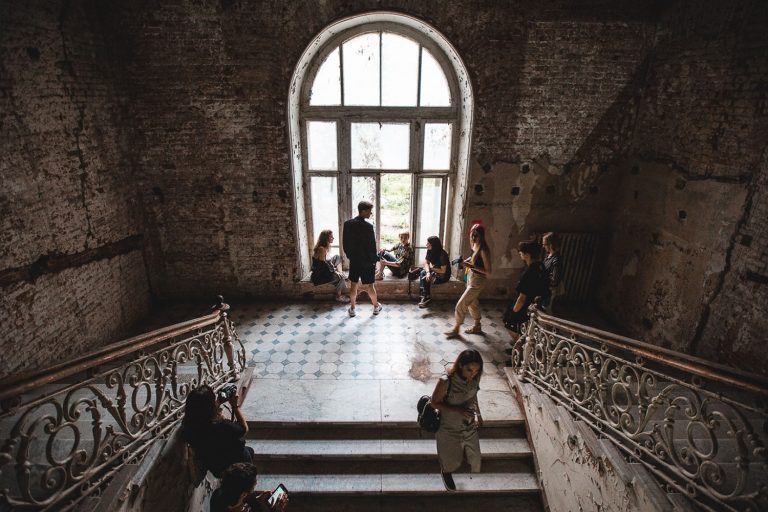
slideshow
The idea of rethinking old buildings has always accompanied the organisation’s activities. It was the same with The Construction, where events took place in different locations of Dnipro city: the philharmonic hall, the aquarium, the Botanical Garden, the railway station, and so on. Thus, the organisers tell the locals the history of Dnipro, observing buildings that reflect the peculiarities of the city’s life at different times. And new event formats breathe new life into them and make them relevant and necessary again.
It was in 2015 when active military operations unfolded in the east of Ukraine. Donetsk and Luhansk were captured, and the self-proclaimed Donetsk and Luhansk People’s Republics were formed. This and the previous events of the Revolution of Dignity prompted the cultural community of Dnipro to unite with a very practical goal: to prevent the same scenario in the city.
“We constantly discussed the topic together with Lucie Řehoříková from the Czech Center in Ukraine. That here, in Dnipro city, it is necessary to build a cultural outpost from the Donbas and for the Donbas, for people from there.”
Inspired by the success of the festival, the organisers decided to develop the cultural life of Dnipro more globally. There is a need for a platform to combine various cultural initiatives together, says Kateryna Rusetska.
“About four years ago, we started our first unsuccessful attempts. There were four or five of them. We came to different places, found new locations, and sometimes even managed to sign agreements that we would enter that building and develop it. And sometimes we just cleaned up there, and we were told ‘Sorry, but it’s time for you to leave’.”
Since the 90s, almost all real estate in Dnipro has belonged to private owners, and the narratives have changed towards semi-oligarchic ones. When negotiating about a building for the Center, the organisers often encountered the realities of the city, which still lives according to the old ideas, says Andrii Palash.
“This is a part, even the result of our history. It will not be possible to remove it completely, and why would you need to if you can rethink and do new things in the old conditions with the existing knowledge?”

Since 2016, an active search for the location has begun. The first attempt failed due to the inaction of the authorities. The organisers have started with the idea of a European center, whose activities would be accompanied by cooperation with foreign partners and their support. The condition from the investors was to cooperate with municipalities or territorial councils, which would have to provide a place and rent it out for 50 years.
“We have already had agreements with European partners. Representatives from Brussels came to Dnipro and agreed with the municipality twice. But neither of the representatives of the city [who could make decisions] ever showed up for the meeting.”
Because of this, the organization could not receive a million euro grant.
Among the unsuccessful attempts were those to negotiate with private owners, for example, to get one of the floors of the Volodarskyi Clothing Factory. The third location was supposed to be part of the building of the Dnipro Philharmonic. Kultura Medialna also held some cultural events there. The team really enjoyed the room, and it also met all the needs of the space.
“We even managed to come to a meeting with the governor. He said, ‘We heard that you have a million euros. Conduct the restoration of the Philharmonic Hall for twenty million hryvnias — and then we will let you into this place for free’.”
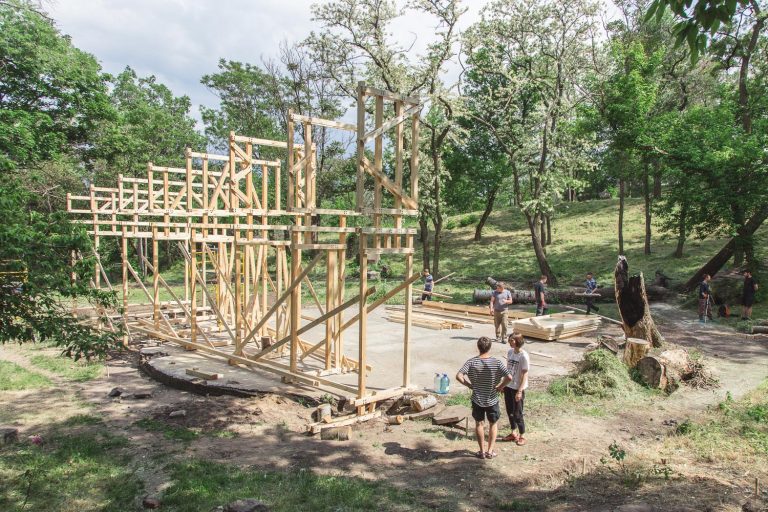
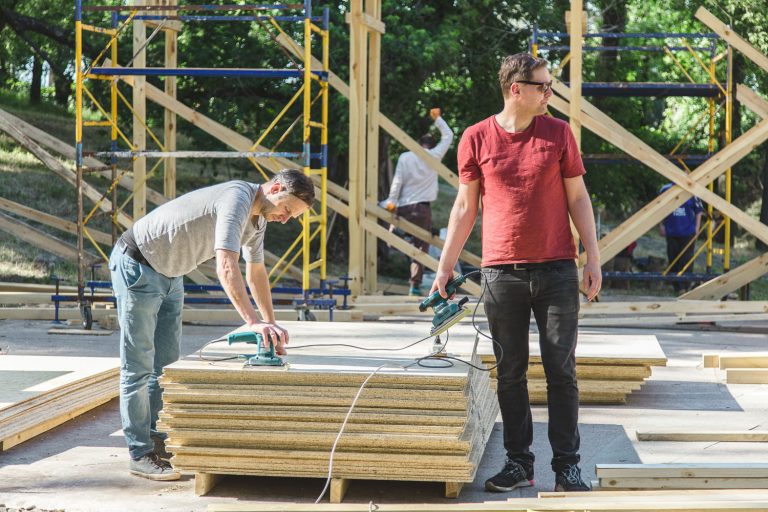
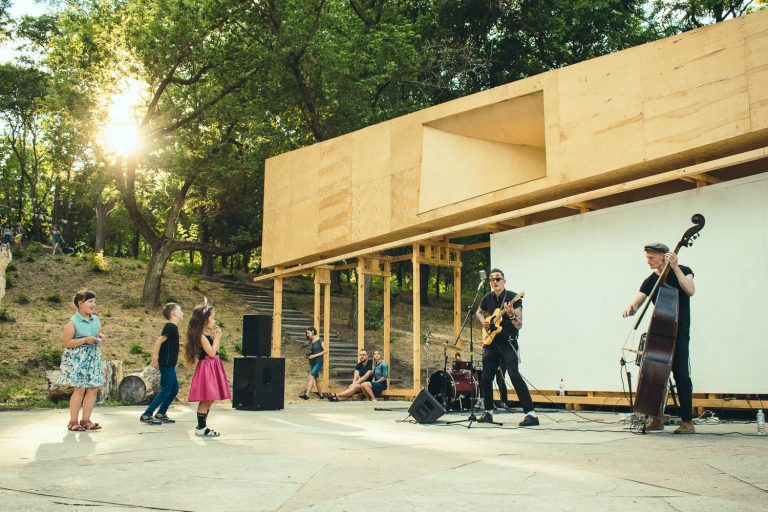
slideshow
After a long experience of attempts and failures, the team began to consider leaving Dnipro city. The last sprint was decided to make a beta version of the cultural space from the existing arsenal of tools and locations, which would not depend on investors’ funds and utilities. So in the summer of 2017, The Stage appeared. This is a crowdsourcing and crowdfunding project that was created in an abandoned part of Shevchenko Park, where there used to be an amphitheater.
About 500 people, including architects and urbanists from abroad, helped with planning and construction. So they created a temporary structure made of plywood and chipboard, where you could hold lectures, film screenings, workshops and just relax.
The main feature of The Stage was accessibility for everyone. The space had a coordinator who formed the schedule of events, as well as a person responsible for technical support. Sometimes an event could be declined when the format was not approved, as a Russian film was once refused to be shown.
“This structure in the park was built based on the research that we had done in the city. Different people were asked — young people, priests or neighbors who live near the park — what is missing here, what design they see, what functions it should perform. So we built the space that people really asked for.”

Photo by Vladyslav Lemm
The success of The Stage helped the Kultura Medialna team to make a name for itself in Ukraine and on the world stage. The idea of revitalization of abandoned territories aroused interest in the Ukrainian experience abroad, and the project received a special reference in the European award for urban public spaces 2018 in Barcelona. It entered the top five there, next to the Zollferein mine in Essen (Germany) and the main square in Tirana (Albania). The Stage was also nominated for the European Union’s ‘Mies van der Rohe Award’ for contemporary architecture. At the same time, the construction of the space took about 200 thousand hryvnias. For comparison, the Zollferain mine has an annual budget of 10 million euros. ‘The Stage’ was made of temporary materials, so after a while it had to be disassembled.
European media began to talk about this public space. Kateryna Rusetska explains that it worked for the image of their organisation. As it turned out, there is a serious demand and desire of people to create a cultural springboard in the city. So, the owners of the building where the Center is now located, offered Kultura Medialna a building to operate in. This prompted the team to stay in Ukraine and create a new city for themselves and its residents.
“The success of The Stage project really showed that we are the team that can work on such cases. That we are the team that can gather people around ourselves, and that these people are there in general, that there is a community in the city.”

Preserve and rethink the territorial council
The building that today houses the Center for Culture in Dnipro is the former Katerynoslav provincial territorial council, like the modern Regional Council. The place at 21A Krutohirnyi descent in the center of Dnipro city is of historical value, and now the DCCC team is breathing new life into it. The house is an architectural monument of local significance and consists of three parts.
Katerynoslav
The name of Dnipro city before 1926. Also its former name was Dnipropetrovsk (until 2016).The oldest name dates to 1852 and there used to be a private residence, says Andrii Palash. Later it was sold to the city and transformed into the Katerynoslav provincial territorial council. At that time, two more buildings were completed — one in 1902, and the other in 1904–1907. With the arrival of the Bolsheviks in 1917, the territorial council was captured, and in 1925, the Red Army Headquarters was organized here.
“If you look at the facade from Krutohirnyi descent, it is still red in color. This is the colour of the Red Army. And from the Uspenska square side, the facade is already white, because this was how the territorial council looked at first.”

When Ukraine became independent, this building became the property of the Ministry of Defense, which sold it to private owners. From that time until 2018, nothing happened here, the building was abandoned for twenty years. In its place, they planned to build a high-rise building, then a shopping center and an Institute for Jewish girls.
The former territorial council building was given to the Center in 2018. Then it was without windows, the roof was heavily leaking, there were no communications, water and ventilation. During two years of repair work, almost everything necessary was restored.
“Since we had previously worked with various abandoned buildings, this one was not a challenge for us. An ordinary location where you can already start doing something tomorrow. For example, in 2019 we already held The Construction festival here.”
Andrii Palash explains that the renovation was made thanks to the loyalty of the owners — The Center of Jewish education charity foundation. The agreement was that Kultura Medialna public organisation rents this building for five years and pays a symbolic one hryvnia per year. Renovations are carried out at the expense of the foundation, and the Center finds funding for cultural projects: exhibitions, festivals, etc.
“Since our organization has a very good grant history, this was not a problem for us. Such a location helps to find additional funds for cultural events. Therefore, we started organizing projects here with our partners, that is, other residents of the Center.”
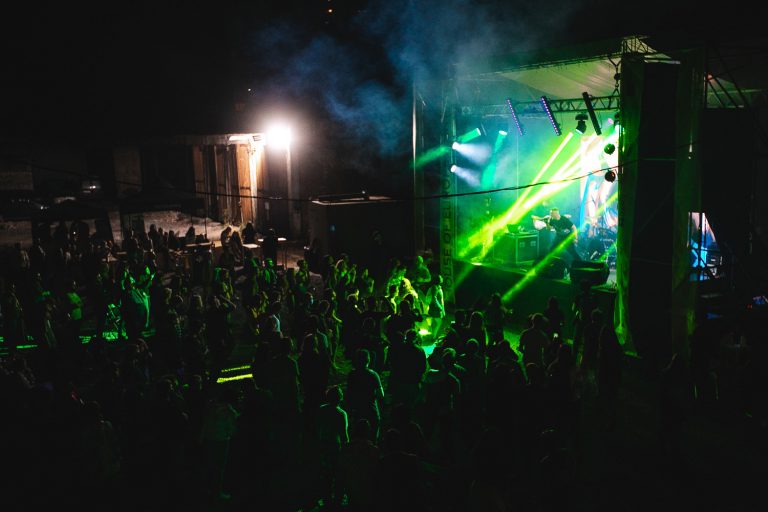
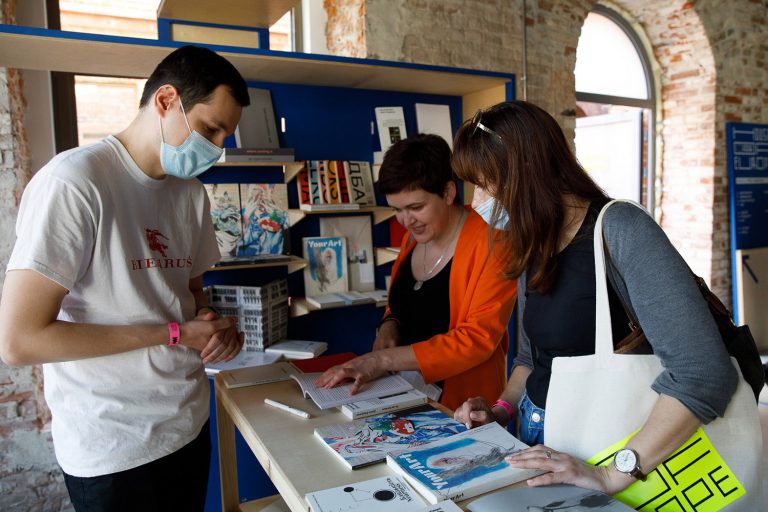
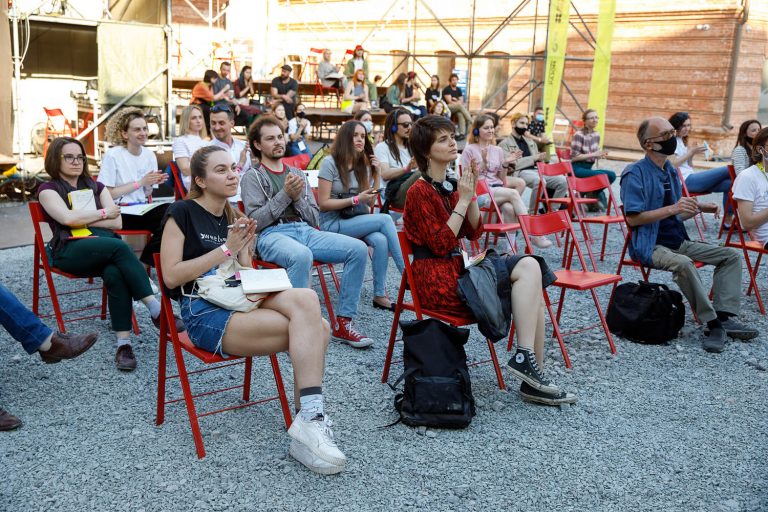
slideshow
In this space, the organisers managed to hold an international residence in 2019, and part of Dnipro GogolFest 2020 was also held here. There was also a large exhibition with the British Council, which was done together with the Artsvit gallery. And in 2021, they managed to hold a large festival called House of Europe.
The latter is an international festival for entrepreneurs and creative industries, which is held annually in various major Ukrainian cities. European and local experts are invited to the festival, lectures are organized, film screenings and concerts are held, and they talk about urbanism, architecture and present startups. The festival was the culmination of the House of Europe temporary hub, which operated in Dnipro during March and April 2021.
Two buildings of the Center were made in the eclectic style, and one more — in the empire style. The House has preserved several authentic details: marble stairs and metal railings, the decor of the lobby with Atlas sculptures on the second floor, stucco molding in the large hall and the adjacent room as well. Most of the halls were left in their original style. Only those premises and objects that are of historical value are restored.
Empire style
An architectural style, which is characterized by pomposity and monumentality. Sometimes, it is called Mykolaiv style because of its active distribution during the reign of Nicholas I.
For example, in the Center there is a door that is about 100 years old. They also are going to be restored, and at the same time they will make a modern heat curtain. (Read also about the restoration of doors in Ivano-Frankivsk.) Andrii Palash explains that a ‘non-interference policy’ is adhered to:
“Often they make a copy when buildings are being restored in Ukraine. But we have a different concept — we try to preserve everything that is possible and leave its authentic look.”
When we designed the plan of the Center for Contemporary Culture, we focused on functionality. All rooms are designed so that they can be easily transformed if necessary, for example, from an exhibition hall to a lecture hall, or into a hall for workshops or for a movie showing.
Andrii says that on the first floor of the Center there is the Artsvit gallery of Modern Art, which has already started working since the beginning of June 2021. Additionally, they plan to make a library, a bookstore and a small cafe here. And on the second floor — exhibition rooms of the entire Center for Culture. There will also be a lecture hall. One of the rooms — the Blue Hall — will be the main one for events in the Center. This is a special-looking room that combines baroque and eclectic styles.

The Center for Cultural. Residents
Today, the Center has several permanent residents. It all started only with the initiator Kultura Medialna team, but the territory of the council has as much as 2800 m2, as well as a yard and garages.
“We realized that we would not be able to fill and revive such a large building on our own, so we decided to set up a creative cluster and gather like-minded people who can also develop here.”
First of all, Kultura Medialna evaluated the experience of the resident-to-be and their previous projects. For example, Artsvit and Ksi Prostir are organizations that have been operating in Dnipro city for more than five years and are close in their value and content. Alliance Française and the Czech Center provide the Cultural Center with international relations and help with integration into the European cultural space.

Kultura Medialna
Kultura Medialna is an organisation that has existed since 2013 and unites cultural managers, curators, and activists. They are engaged in audiovisual contemporary art and new media, project international and interregional residencies, exhibitions, and festivals. This initiative was created thanks to the enthusiasm of friends, as well as dissatisfaction with the cultural situation in the city.
“We realised that in such a big city there are not enough experimental projects and discourse around modern culture. Therefore, on the threshold of revolutionary events in Ukraine, we decided that we had a choice: either leave Dnipro city, or try to change something here. And we tried to change something.”
Andrii Palash talks about an expedition study of old cultural institutions experience. In Ukraine, there is a Post-Soviet heritage like conservative houses of art or culture, where almost nothing is happening now. Andrii and his friends decided to do research about these buildings in Dnipro and the surrounding area as well.
“Sometimes we were welcomed with a special bread called korovai and homemade wine. We were told how cool everything was for them, because we were considered representatives of the Department of Culture and thought that this was an inspection ‘from the Center’.”

Later, based on the results of the expedition, an exhibition of contemporary art was organised in the Literary Prydniprovia museum. The team plans to continue its research throughout Ukraine, because the phenomenon of these institutions is closely related to the idea of urban spaces revitalisation.
Today, Kultura Medialna oversees cultural events in the city together with other residents. Kateryna Rusetska says that along with the change in the direction of the organisation’s activities, the perception of Dnipro city has also changed.
“The idea of Kultura Medialna is in avant-garde contexts and ideas. But the events in the country have completely changed the direction of our activity. Now we are focused on educational projects, and we have started to talk and think more in a socially critical way. For us, the city is not only a platform for events, but also a platform for the development of civil society.”

Ksi Prostir
Another resident of the Center is Ksi Prostir. This is a youth laboratory that organises residences for aspiring artists, holds exhibitions, concerts and is engaged in non-formal education. Nadiia Koval and Iva Naidenko, its curators and founders, know from their own experience how important it is to help young artists.
“Ksi Prostir is a kind of interdisciplinary cultural hub. We are very inspired to help young artists, especially local ones, so that they can develop here. For this, we are creating an open workshop here in the ‘makerspace’ format. Here you can come and work on your own art projects.”
As an independent initiative, Ksi Prostir has existed since 2014, but for a long time the team worked unofficially solely out of enthusiasm and on a volunteer basis. In the summer 2021, they are planning to hold the first event on the territory of the Center: an art lab, where young artists will be able to learn new techniques for working with wood and metal, and then develop their own projects.
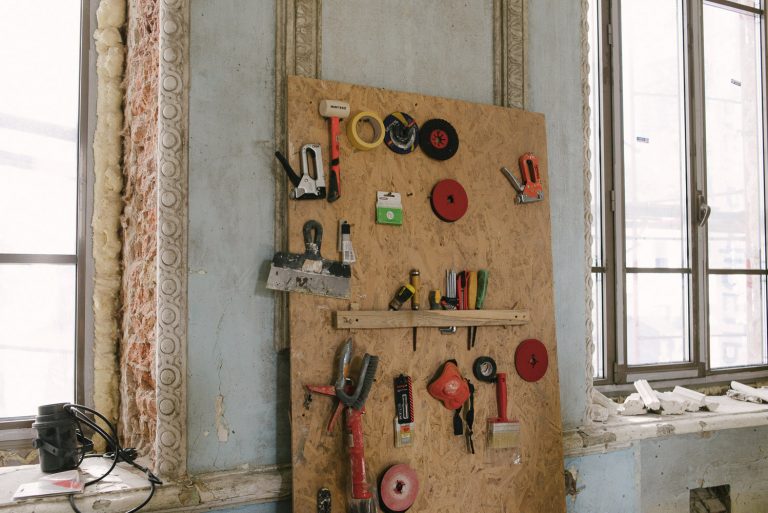
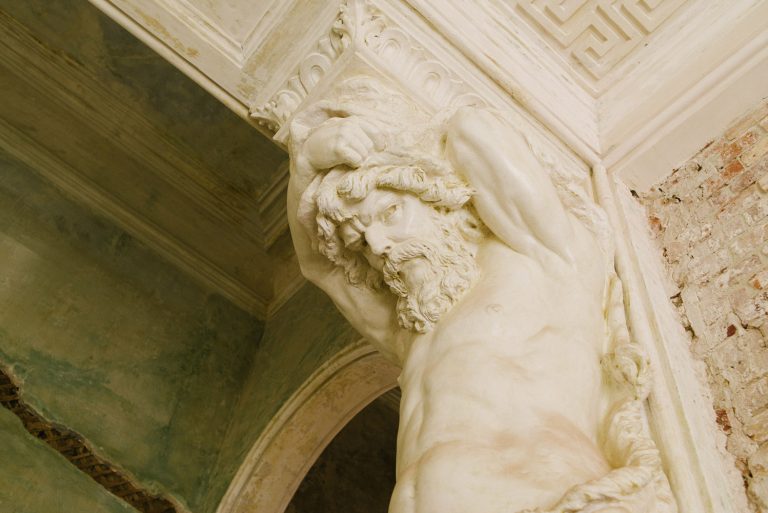
slideshow
The team wants to create convenient conditions for the realisation of new talents particularly in Dnipro, because they know how difficult it is to find ‘your place’ here. Nadiia and Iva started the initiative as students of the Faculty of Architecture. Back then, they acutely experienced the lack of creative space in the city where artists could work and communicate. At first, they rented an apartment for this purpose, then they started thinking more globally — about a place where you can exhibit your work. Later on, Ksi Prostir moved to the Art Factory — a space from the Union of Artists of Ukraine, which, according to the founders, mainly includes conservative artists.
“Unfortunately, the Art Factory does not fulfill its function today. Therefore, Ksi Prostir is an alternative to such a community. Our goal is to create everything accessible to the maximum number of people, so for six years we had been holding all events for donations only, that is, we did not earn anything from it.”
At Ksi Prostir they combine art with engineering and science, making projects at the intersection of different industries. In the youth laboratory on the territory of the Center, artists can start with support, a location and a curator. Here we are sure that every person is an artist and each work can be approached as a creative work.

Alliance Française
Alliance Française, a public organization in Dnipro, is a representative office of the Alliance Française Foundation in Paris, which promotes French culture and establishes friendly relations between France and Ukraine. There are already 6 centers in Ukraine — in Dnipro, Zaporizhzhia, Kharkiv, Lviv, Rivne, and Odesa.
Thibaut Ayun, director of Alliance Française in Dnipro, explains that it is important not only to help develop international projects in the city, but also to introduce Ukraine to people in France this way.
“Ukraine is like terra incognita for France. People don’t know where it is and what is here. But I believe there are a lot of good things here. I want the French who will visit Dnipro to say later, ‘Yes, Ukraine is very interesting!’ People here know more about France than the other way around. Therefore, the task of our project is to fix this.”

The Alliance Française has been in the DCCC building for a short time, but has already managed to work together in the House of Europe project. Thibaut Ayun is convinced that this is a very important cooperation for both sides.
“We have many partners in the city — these are philharmonic societies and museums. But we have never had such a young team working with contemporary art before. And this is extremely important, because France is not only Victor Hugo. Also, Ukraine is not only Taras Shevchenko. Now there are a lot of talented people here who need to be helped and given a chance. I think the Center is a breath of fresh air.”
Generally, there are three areas in which the initiative works: they study French and organise a language exam, hold cultural events, and work to improve relations between Ukraine and France. Andrii Palash, the founder of the Center for Contemporary Culture, sees this cooperation as beneficial not only for the Center, but also for Dnipro as a whole.
“One of the goals of the Center for Contemporary Culture is to build a bridge between Dnipro, Ukraine, and the rest of the world, and therefore such residents as the Alliance Française or the Czech Center are a very cool glue that connects us, Dnipro, and our people with the culture of other countries. This is a great strategic move for us, and perhaps more international residents will join in the Center later. In any case, we are always glad to have such cooperation.”

Artsvit
Artsvit is another resident of the Center. This is a contemporary art gallery that has been operating since 2013. There are modern and Soviet collections here, but the main focus of the gallery lies in the popularisation of contemporary Ukrainian Art in Ukraine and in Dnipro in particular. Artsvit also published several books. This is, for example, the ‘Dnipro School of photography’ — a photo book where the works were published of artists related to the ‘Youth section’ of the Dnipro Photo Club, which existed in the 1990s (read also stories about famous photographers of Kyiv).
The Kultura Medialna team cooperates with Artsvit from another festival called ‘The Construction’. And a few years ago, they engaged Iryna Polikarchuk, the gallery’s director, to develop a strategy, business plan and content plan for the Center for Contemporary Culture.
Iryna Kharlamova who is the Project Manager says that Artsvit (like any gallery) has a permanent program and works with exhibition projects. About seven to eight exhibitions are held per year. Much attention is paid to educational projects (for example, lectures on art) for both children and adults. The Center has become a serious step forward for the gallery, because now there is enough space for both exhibitions and lectures.

‘A Long Path’
The public initiative called A Long Path revitalizes the green areas of Dnipro, in particular, Dovha Balka which is in a neglected state. The team does not use asphalt or plastic to restore it — only wood and other materials that were found on the territory of Dovha Balka. This project won a grant from the Youth Active City program initiated by Kultura Medialna. According to Andrii Palash, “The Long Path” is one of the best initiatives that they decided to support.
The Long Path team temporarily uses garages on the territory of the Center for Carpentry. In Soviet times, these garages were designed for military equipment. In the future, the organisers plan to create workshops, studios and storage facilities of the Center for Contemporary Culture here. Coordinator Oleksii Orlov is grateful to the Center for its openness to cooperation and accessibility.
“For Dnipro, the Center for Culture is important because it is another — or perhaps the only — reason not to leave Dnipro city, to stay here and create some meaning. In collaboration with artists and activists.”

Develop culture through education. Andrii
Andrii Palash, the head of the Kultura Medialna organisation, also works at the Dnipropetrovsk Professional Art College of Culture as the head of the Department of Innovation and International Cooperation. He says that since 2020, the department has developed a new major, Management of Socio-Cultural Activities. It is very important for the institution, because before that there were no majors in the city that managers for culture could study. And with a professional education, more people will be able to implement large-scale projects.
“We call Dnipro a ‘cultural frontier’, because here you can do everything. And if there are more managers for culture, or art managers, or curators, then culture will also develop here. There will be more urban projects, exhibitions, concerts, and festivals.”
Andrii has a technical education, but has already received a cultural one in 2016, when he studied at the Vishegrad Academy of Cultural Management. After that, there were also internships in Dresden, Germany, and Ljubljana, Slovenia, but he says that there was always a need to return to Ukraine.
The founder of the Center says that due to the former closeness in certain industries, Dnipro city is now a good platform for the development of creative industries. So there is still no Museum of Modern Art in the city, and there is only one such gallery. Also at the College of Culture, Andrii is working on a project to create an Academy of Culture and Arts, because there is still no higher education institution with this specialization in Dnipro.

Andrii Palash is sure that in order to build new meanings, you first need to understand and explore your history. And to explore your history, you need to preserve it. And the opening of the Cultural Center is an accurate illustration of this.
“Culture is not just about art, exhibitions, and artists. It’s also about informal and quality education. It’s about exchanges. Culture is about the heritage that remains, about the history.”
supported by
House of Europe is an EU-funded programme fostering professional and creative exchange between Ukrainians and their colleagues in EU countries. Implementation of House of Europe Programme is led by Goethe-Institut Ukraine with The British Council Ukraine, Institut français d’Ukraine and Czech Centres as Consortium Partners
